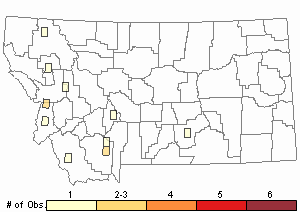View in other NatureServe Network Field Guides
NatureServe
Montana
Utah
Wyoming
Idaho
Wisconsin
British Columbia
South Carolina
Yukon
California
New York
Big-eared Radix - Radix auricularia
General Description
Radix auricularia, the big-ear radix, is a species of medium-sized freshwater snail, an aquatic pulmonate gastropod mollusk in the family Lymnaeidae.
Diagnostic Characteristics
The shell is thin, roundly ovate and very inflated, such that the last whorl comprises 90% of its volume. The shell has a rounded and broad spire that pinches in steeply at the apex. The spire short, conic, very small compared with the last body whorl. The width of the shell is from 12-18 mm, and the height of the shell is 14-24 mm. The shell of Radix auricularia has a width to length ratio greater than 0.75.
Range Comments
Radix auricularia is native to Europe and Asia. This is a truly globally distributed species occurring across all of Europe, Russia, in eastern Asia, southern China and northern French Indo-China, India, Afghanistan, Persia, and Iraq, the Gulf of Oman and Lower Mesopotamia, Egypt and Yeman and is introduced across North America (Hubendick 1951).
Observations in Montana Natural Heritage Program Database
Number of Observations: 14
(Click on the following maps and charts to see full sized version)
Map Help and Descriptions
Relative Density

Recency



 (Observations spanning multiple months or years are excluded from time charts)
(Observations spanning multiple months or years are excluded from time charts)
Habitat
This species is found in freshwater lakes, ponds, and slow-moving rivers with mud bottoms. Radix auricularia can live on boulders or vegetation in low or high-flow environments, and is capable of tolerating anoxic conditions, but it tends to prefer very lentic waters in lakes, bogs or slow rivers where there is a silt substrate.
It has been found in environments with a pH from 6.0–7.1.[5][17] Its average thermal preference is ~19°C, but there is great fluctuation around this mean, depending on the photoperiod for the time of year.[18] In Great Britain, the species is restricted to hard water.[19] It can tolerate polysaprobic waters, or areas of major pollution and anoxia with high concentrations of organic matter, sulfides and bacteria.
Food Habits
Radix auricularia is in the gastropoad family Lymnaeidae, which are largely scrapers and collector-gatherers. This species feeds on such items as detritus, diatoms and Cladophora spp. (algae).
Reproductive Characteristics
Like almost all pulmonate snails, this species is a hermaphrodite. It undergoes oogenesis in spring as the daylight hours increase, and spermatogenesis in late summer and early fall as the daylight hours decrease. It lays its eggs in clumps of 50 to 150 eggs
Management
Documented in Montana sites in the Beaverhead drainage in SW Montana, may have been introduced from Idaho. We recently found this introduced snail in the Bitterroot River Draiange of Montana during a Bioblitz on the Lee Metclaf Wildlife Refuge.
References
- Literature Cited AboveLegend:
 View Online Publication
View Online Publication Hubendick, B. 1951. Recent Lymnaeidae. Ttheir variation, morphology, taxonomy, nomenclature, and distribution. Kunglica Svenska Vetenskapsakademiens Handlingar Series 4, 3(1): 1-223.
Hubendick, B. 1951. Recent Lymnaeidae. Ttheir variation, morphology, taxonomy, nomenclature, and distribution. Kunglica Svenska Vetenskapsakademiens Handlingar Series 4, 3(1): 1-223.
- Web Search Engines for Articles on "Big-eared Radix"
- Additional Sources of Information Related to "Snails / Slugs"





